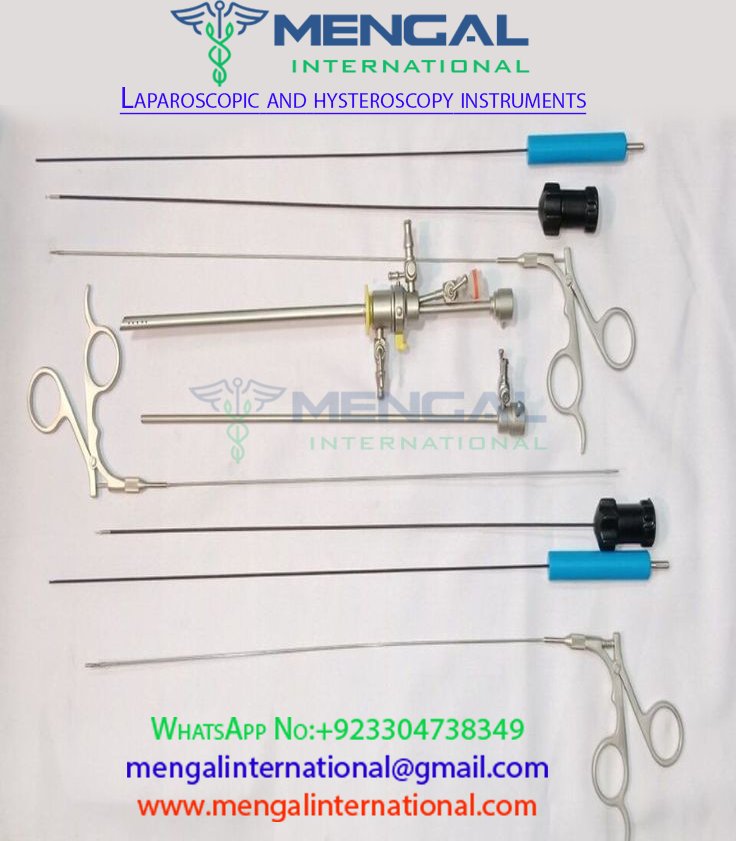Laparoscopic and hysteroscopy instruments
This set includes semi-rigid instruments with features like
alligator jaw,
scissors,
rotatable, and spatula forceps.
Perfect for a variety of medical disciplines including neurology, urology, obstetrics & gynecology, and more.
Made by Mengal International and all instruments are reusable and autoclavable.
Description
Laparoscopy and hysteroscopy are two important techniques in modern gynecological and surgical practices, each requiring specialized instruments for effective diagnosis and treatment. Here’s a detailed note on the instruments used in both procedures:
Laparoscopy Instruments:
1. Trocars:
- Purpose: Trocars are sharp instruments used to create initial access ports into the abdominal cavity.
- Types: They come in various sizes and designs, including disposable and reusable options.
2. Laparoscope:
- Purpose: This is a long, thin optical instrument with a camera and light source at one end, used to visualize the abdominal cavity.
- Types: Different scopes offer varying angles of view (0°, 30°, 45°) and diameters for different surgical needs.
3. Graspers and Forceps:
- Purpose: These instruments are used for grasping, manipulating, and retracting tissues or organs during surgery.
- Types: Fenestrated graspers, atraumatic graspers, and bowel graspers are commonly used.
4. Scissors and Dissectors:
- Purpose: Used for cutting and dissecting tissues, vessels, or adhesions during surgery.
- Types: Includes various lengths and designs for precise cutting and dissection.
5. Electrosurgical Instruments:
- Purpose: Used for cutting and coagulating tissues using electrical current.
- Types: Monopolar and bipolar instruments, such as electrodes, hooks, and scissors.
6. Suction/Irrigation Devices:
- Purpose: Used to clear the surgical field of blood and fluids, as well as to irrigate the area for better visualization.
- Types: Handheld suction/irrigation devices with various tip designs.
7. Needle Drivers:
- Purpose: Used to grasp and manipulate needles for suturing during laparoscopic procedures.
- Types: Straight and curved needle drivers with different jaw designs for various suturing techniques.
8. Endoscopic Clip Appliers:
- Purpose: Used to apply hemostatic clips or ligating clips on blood vessels or tissues.
- Types: Disposable and reusable, with different sizes to accommodate various vessel diameters.
Hysteroscopy Instruments:
1. Hysteroscope:
- Purpose: Similar to a laparoscope, a hysteroscope is a thin optical instrument used to visualize the inside of the uterus.
- Types: Different diameters and angles (0° and 30°) are available, with integrated channels for fluid and instruments.
2. Hysteroscopic Sheath and Obturator:
- Purpose: The sheath provides a pathway for the hysteroscope and protects the tissues during insertion.
- Types: Various sizes to accommodate different hysteroscope diameters.
3. Resectoscope:
- Purpose: Used for operative hysteroscopy, particularly for removing polyps, fibroids, or uterine septa.
- Components: Includes an outer sheath, inner cutting loop or electrode, and an irrigation system.
4. Hysteroscopic Graspers and Scissors:
- Purpose: Used for manipulation, grasping, and cutting tissues within the uterus during surgery.
- Types: Atraumatic graspers and scissors designed for hysteroscopic procedures.
5. Fluid Management Systems:
- Purpose: Essential for maintaining clear visualization by distending the uterus and clearing debris.
- Components: Includes pumps, tubing sets, and fluid containers with temperature regulation.
6. Biopsy Forceps:
- Purpose: Used to obtain tissue samples (biopsies) from the uterine lining for pathological examination.
- Types: End-cutting and side-cutting forceps of various sizes.
7. Uterine Manipulators:
- Purpose: Used to manipulate and position the uterus for better visualization and access during hysteroscopy.
- Types: Include mechanical and inflatable manipulators.
Conclusion:
Both laparoscopic and hysteroscopic instruments are crucial for minimally invasive surgical procedures in gynecology. They enable precise visualization, manipulation, and treatment of gynecological conditions while minimizing trauma and enhancing patient recovery. Advances in technology continue to refine these instruments, improving surgical outcomes and expanding the scope of what can be achieved through minimally invasive techniques.




Reviews
There are no reviews yet.